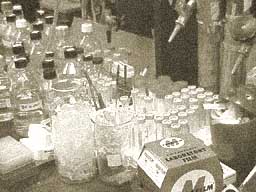|
|
 |
 |
Chitin Content Assay
2
(adapted from: Chester, C. R., Jr., Harris, J. L., Jacobs, C.
W., and Szaniszlo, P.J. 1984. Effects of polyoxin AL on cellular development in Wangiella
dermatitidis. Experimental Mycology 8, 349-363.) |
Index:
(to jump to a listing, click on the desired name to the right) |
Materials
Protocol
Results
Tips |
| |
Principle
and General Applications |
| |
This chitin content assay was used with
developing multicellular forms and with samples grown at 37°C in the presence or
absence of Polyoxin-AL (3 mg/ml, final concentration) in 30-ml cultures contained in
triplicate 250-ml Erlenmeyer flasks. |
| |
(Back to
the top) |
| |
Materials |
| |
0.45-µm membrane filters (Millipore
Corp., Bedford, Mass.)
glass beads (0.45-0.50 mm)
5% KHSO
5% NaNO2
12.5% NH4SO3NH2
0.5% 3-methyl-2-benzothiazolone hydrazone HCl
0.5% FeCl3 |
| |
(Back to
the top) |
| |
Protocol |
| |
- Adjust inoculum level to approximately 106 cells/ml.
Periodically remove aliquots from cultures to measure the cell numbers.
-
Collect remainder of culture by filtration using
0.45-µm membrane filters (Millipore Corp., Bedford, Mass.) previously dried to a constant
weight at 65°C. Determine the dry weight of each sample.
-
Dissolve the filters using repeated washes of acetone,
removing the residue each time. Allow the acetone to evaporate.
-
Add 0.5 g of glass beads (0.45-0.50 mm) to each sample
to facilitate dispersal of the residue prior to alkali extraction
-
After redefining the assay volume, assay
acetone-extracted material for chitin based on the Ride and Drysdale method:
Physiol. Plant Pathol. 2 (1972)
7-15.
A. Add the following reagents to digest the samples:
The concentrations (% w/v) and volumes (in
ml) of the reagents used were:
suspension of
extracted cells, 1;
5% KHSO4,
1;
5% NaNO2, 1;
12.5% NH4SO3NH2,
0.33;
0.5%
3-methyl-2-benzothiazolone hydrazone HCl, 0.33;
and 0.5%
FeCl3, 0.33
B. Determine absorbance spectrophotometrically at 650 nm.
Prepare Glucosamine-HCl assay as a standard
|
| |
(Back to
the top) |
| |
Results |
| |
|
| |
(Back to
the top) |
| |
Tips |
| |
|
| |
(Back to
the top) |
 |
This page updated on:
Saturday, April 22, 2006 12:08:02 PM |
|
|
|
|